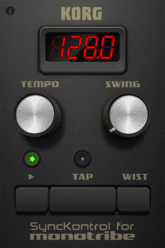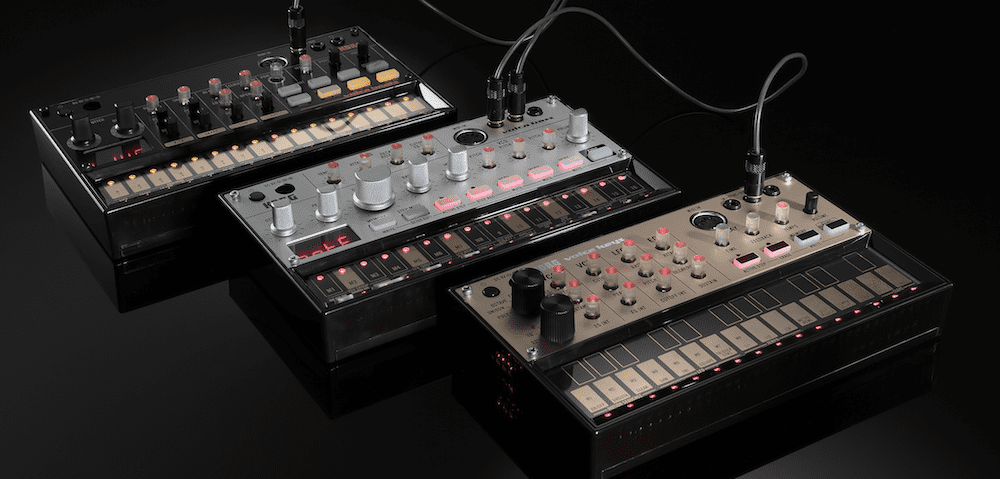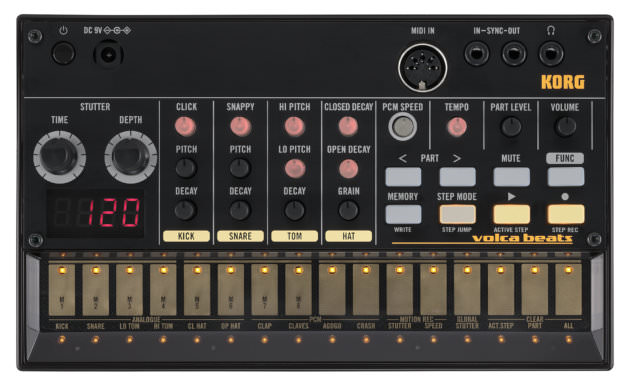Volca Beats
The Beats offers six analogue sounds (kick, snare, lo and hi toms, closed and open hats) and four PCM samples (clap, claves, agogo and crash cymbal). The combination of analogue circuits and samples is nothing new (the Roland TR-909, for instance, used samples for its hi-hats and cymbals), allowing samples to be used for less important sounds or those which are particularly tricky to synthesise with analogue circuits, such as claps. In this case, most of the analogue sounds are quite impressive – the kick drum in particular can get seriously weighty, although the snare is a bit of a let-down.
Although there are only a limited number of adjustable parameters on offer, they provide a surprising range of sounds. The kick, snare, toms and hats all have adjustable decay. All but the hats have adjustable pitch. The kick adds a ‘click’ control for shaping the attack, the snare has an 808/909-style ‘snappy’ control, while the hats share a ‘grain’ control which adjusts the (digitally generated) noise used to synthesise them, altering the timbre. If that doesn’t sound like many options, bear in mind it’s a lot more than some of the classics which inspired the Volca Beats; the 808, for instance, doesn’t offer any control of the kick or snare’s pitch, while the 606 doesn’t offer any sound controls apart from a ‘secret’ method of adjusting the decay of the hi-hats.
The playback rates of the PCM sounds can be adjusted individually, and it’s interesting to note that the rate control extends further than might be expected in each direction, allowing for some interesting effects as the sounds are stretched and squashed beyond their normal range.
Like so many of the classic 70s and 80s analogue drum machines, the step sequencer in the Beats offers a combination of real-time and step-entry recording. In real-time mode, beats can be played in by tapping the ribbon. In step mode, each drum can be programmed using the 16 buttons. The individual levels of each drum part can be adjusted, while holding down the Mute button allows individual parts to be dropped in and out.
In addition to the obvious features, the Beats also features a stutter effect and a similar motion sequencing feature to that found on the Keys. The stutter effect can be applied individually by part or globally to all parts. When applied, it re-triggers drum hits rhythmically, with the repeat time determined by the time setting and the number of repeats by the depth control. It’s a little heavy-handed when applied globally, but at more subtle settings it can add an interesting variation with a subtly different sound to a delay. Furthermore, at very short stutter times it can sound almost like a spring reverb.
 The motion sequencing option isn’t as comprehensive as the implementation found on the Keys, but it does allow automation of PCM playback rates and stutter time and depth. Some interesting effects can be created by automating rapid changes to the PCM playback rates or stutter time. Pitched sounds like the toms and agogo can be turned into melodic sounds or FX.
The motion sequencing option isn’t as comprehensive as the implementation found on the Keys, but it does allow automation of PCM playback rates and stutter time and depth. Some interesting effects can be created by automating rapid changes to the PCM playback rates or stutter time. Pitched sounds like the toms and agogo can be turned into melodic sounds or FX.
The one major weakness of the Beats is the omission of a swing control. This is true of all three of the Volcas, but it’s missed the most when programming drums. Thankfully, there’s a relatively simple solution, which is to feed the Volca with a swung trigger signal. Korg offers the free SyncKontrol iPhone app for the Monotribe which will also work with the Volcas. We’d love to have seen a swing control built into the unit, but at least the app provides a workaround.
Conclusion
If the Monotron showed Korg still had an interest in analogue synths and the Monotribe reintroduced grooveboxes into the collective conscious, the Volca Beats does the same for analogue drums. It’s the closest modern equivalent to some of the more simple analogue drum machines of the 1980s. As such, it’s got an obvious advantage, simply because there are no real analogue alternatives in this price range. The closest would be something like the MFB 522 or 503 – fine drum machines in their own right, probably with an edge in terms of pure sound, but more limited and nearly twice the price. The Volca Beats may not be likely to replace anyone’s 808 or 909 in a hurry – or to compete with the likes of the Tempest, Machinedrum or Tanzbär at the top end of the current drum machine market – but it’s certain to introduce a new generation of artists to the joys of real-time drum step sequencing.
The groovebox concept found in the Monotribe is taken even further by the Volca Keys and Volca Bass. In fact, the two synth-focussed Volcas leave the Monotribe looking a little redundant. With significant improvements in the sequencing and synthesis options on offer, the Keys and Bass hark back to the ever-reliable but increasingly long-in-the-tooth Electribe range. While the Electribes could conceivably form the centrepiece of a production setup (as they do for artists including Xosar), the Volcas have to be judged in context as much cheaper, more limited devices: the raw sounds of the Beats are solid if not always jaw-dropping; the Bass and Keys provide surprisingly flexible synth engines in such small packages.
There are very few major weaknesses to any of the Volca units. There’s no MIDI output, but that can be added with a mod. Swing can be achieved with the iOS app, sequencing via MIDI solves any shortcomings of the built-in ribbon keyboards and sequencers, while the sound engines themselves are incredibly impressive for the price. They may not be world-conquering synths when viewed individually, but sync them to a MIDI clock from other gear or your DAW and they become a lot more serious. And ultimately that’s the most important thing: the Volcas are cheap, they’re immediate, they’re fun, but they’re also very useable in terms of actually making music. Don’t be surprised to hear them all over the place in the next couple of years.
The Verdict
Price: £143.99
The Final Word
Game-changing additions to Korg's ever-expanding analogue range.


09.14 AM
Check that crazy demo of the Korg Volca Beats
http://youtu.be/tz2cwESyzeI